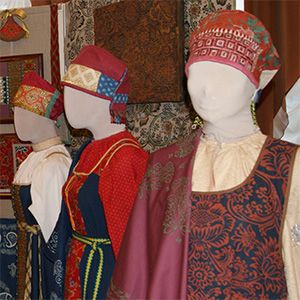Folk costume

National clothes is part of culture of the people, reflect its history and traditions. The folk costume is formed under the influence of climate, geographical location, economic structure, type of activity and world outlook of people. In addition, national clothes always carried information about the social status of a person, emphasized the age and family characteristics.
It is believed that the Russian national costume began to evolve around the 12th century, during the formation of the Russian nation. It was used by all estates up to the beginning of the 18th century, when Tsar Peter I actively began to invite foreigners to Russia and to embed the elite to European culture. After the decree of 1699, the national costume disappeared in the aristocratic environment. He was allowed to wear only to peasants, monks and priests.
A distinctive feature of the Russian folk costume was the presence of many components and many layers. Folk costumes were very diverse. Since ancient times in Russia, natural fabrics have been used for their production: cotton, linen, hemp cloth or sheep's woolen cloth. They were stained with natural paints, often in bright colors (white, blue and red predominated), richly decorated with braid, beads, embroidery.
In the Russian folk costume, a clear division into informal, festive and ceremonial dress was observed (for weddings, churches, funerals, etc.). Casual clothes were simple enough, consisted of the most necessary elements, sewed from inexpensive, but strong fabrics. For comparison, the daily women's outfit could include only seven items, and festive – up to twenty. Festive clothes were more richly decorated, using silk and gold threads, beads, sewed from expensive fabrics. The festive attire was a real treasure for the family and passed down from generation to generation.
The beauty of the costume depended on the imagination of the masteress and her ability to make clothes not only unique, but also "talking" about the place of residence, social status, age, marital status and the type of activity of its owners. Often the creation of a single costume took more than a year.
In Russia, there were two main types of women's costumes: sarafan complex (northern and central Russian regions) and ponyova (south Russian). Sarafans – dresses without sleeves – differed in fabrics and cut (deaf, sweeping, on straps, with a seam in front or on buttons, etc.). For the Vladimir province were characteristic Old Believers sarafans, designed with red underside and beautiful coattails behind, formed by the oblique cutting. Ponyova is a woman's skirt, usually consisting of three pieces of cloth (deaf or sweeping), with a richly decorated hem. Ponyova was an essential part of costume of a married woman. The basis of women's attire has long been a long shirt, which was dressed under a sarafan or a ponyova. As a rule, the shirts were made of linen or cotton, and the more expensive ones were made from silk. They were decorated with a rim or embroidery.
The obligatory component of the Russian folk costume was a headwear, which completed the entire outfit, making it whole. Headgears were different for unmarried girls and married women. Girl's headdresses – ribbons, bandages, hoops, shawls folded with a bundle – left a part of the hair open, and were quite simple. Married women’s hair was completely hidden under a headdress – kika, kokoshnik. The anterior solid part of a kika was performed in the form of horns, hoofs or scapula. A smart soroka – the top part of a headdress made of red bunting, silk or velvet – was wearing on top of a kika. Behind a kika, hair was covered with a cloth (pozatylnik), often decorated with beads. In winter, when leaving the house, women covered such a headdress with a shawl.
Ethnographers, historians, local historians are engaged in the study and restoration of folk costumes. The works of Olga Chemodanova, master of the history of folk costume, are known on the Vladimir land. She studies historical sources and manually recreates clothes, according to original samples and watercolors of artists. Olga Chemodanova is a participant and a diplomatist of numerous folk costume shows and festivals. She owns old techniques of needlework: beadwork, gold embroidery, weaving belts. High appreciation of specialists in folk art received her collections "Russian folk costume", "Stylized costume", which are exhibited in many cities of Russia.
In the Sudogda House of folk art Olga Chemodanova created the theater of folk costume "Tradition" and amateur association "Sudarushka", where she conducts master classes in weaving, sewing a Russian costume, embroidering and weaving belts, reviving the traditions of the Vladimir province.
Address: Vladimir region, Sudogda, Lenina st., 10.
Phone: +7 (49235) 2-35-40
 Tourism portal of the
Tourism portal of the